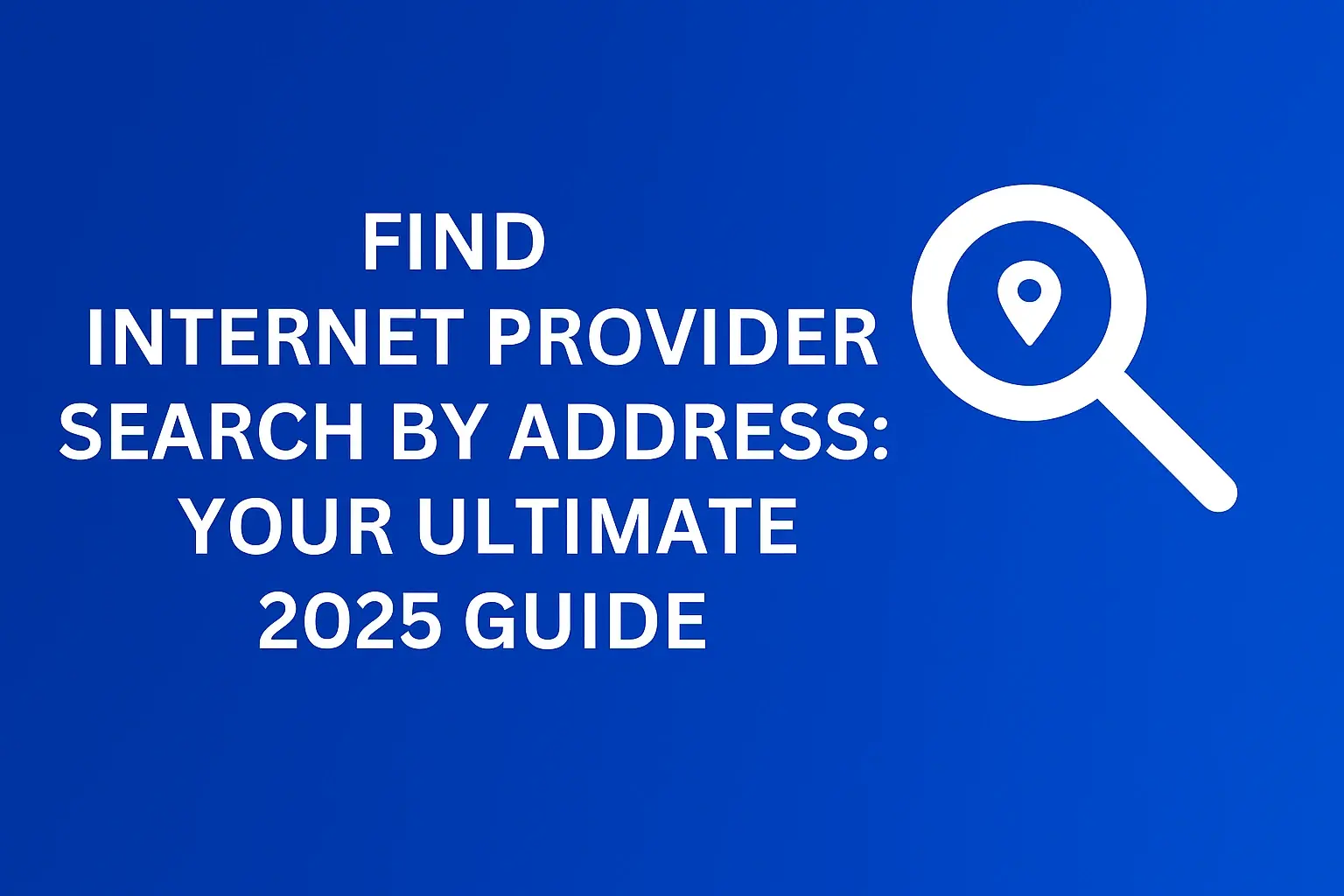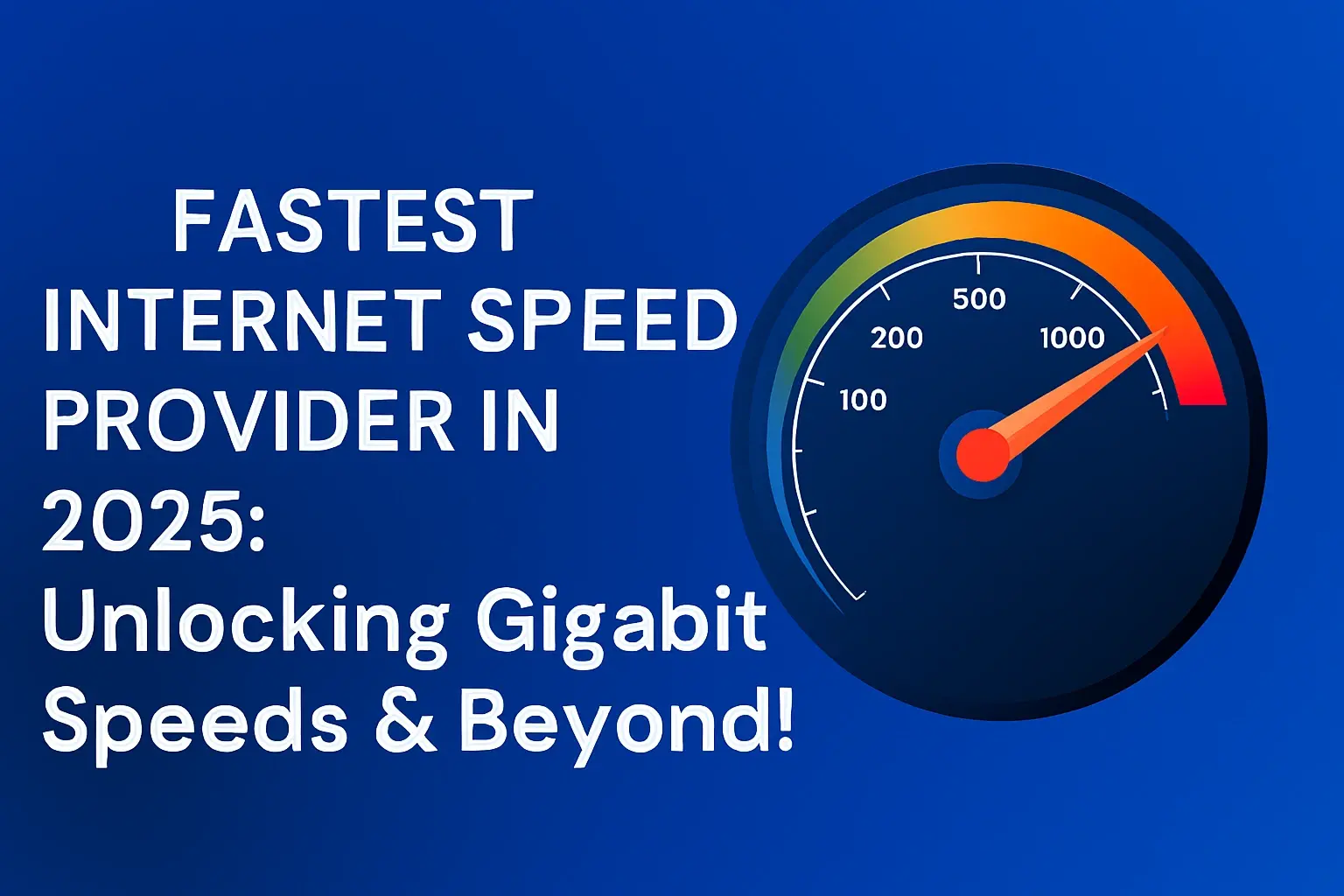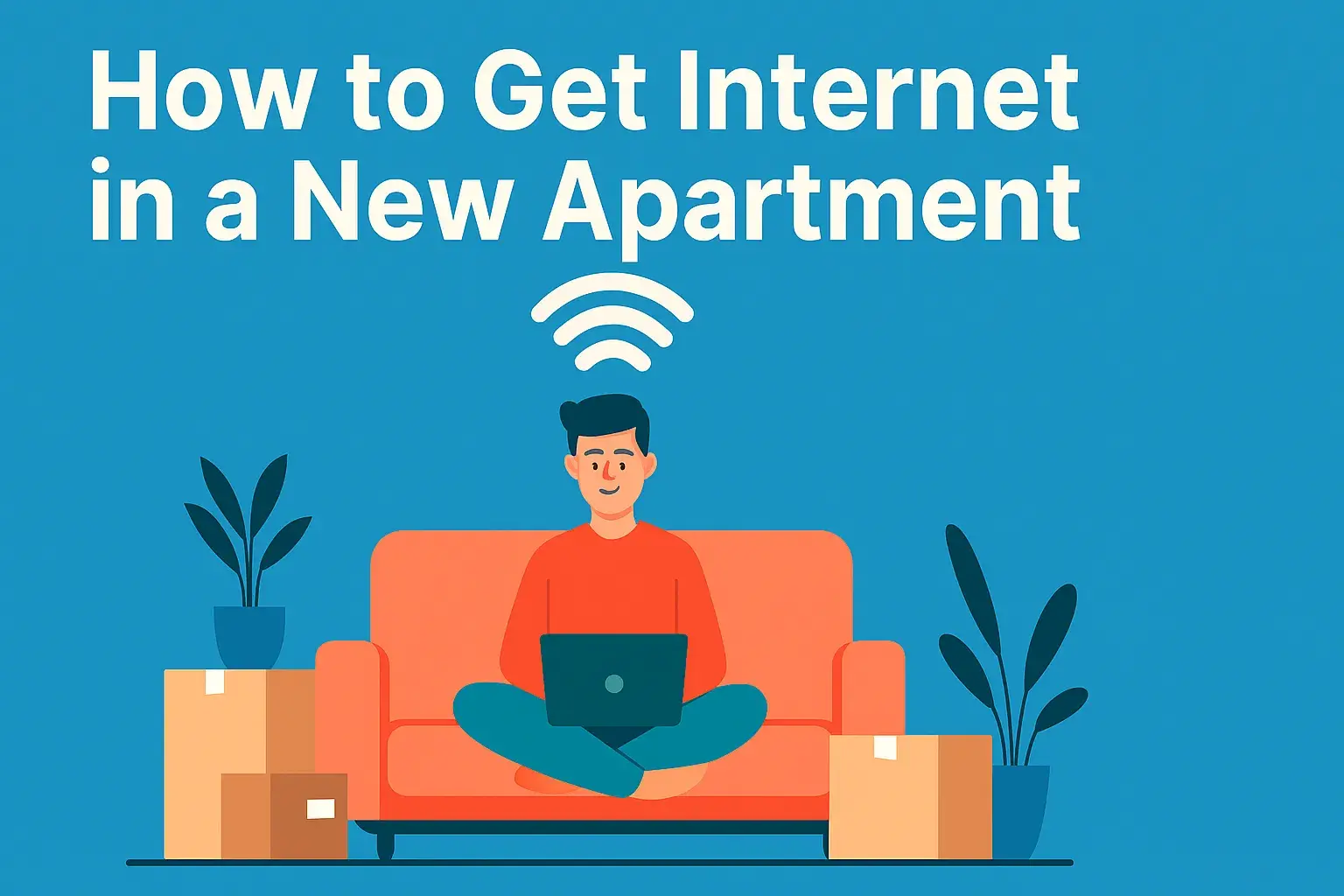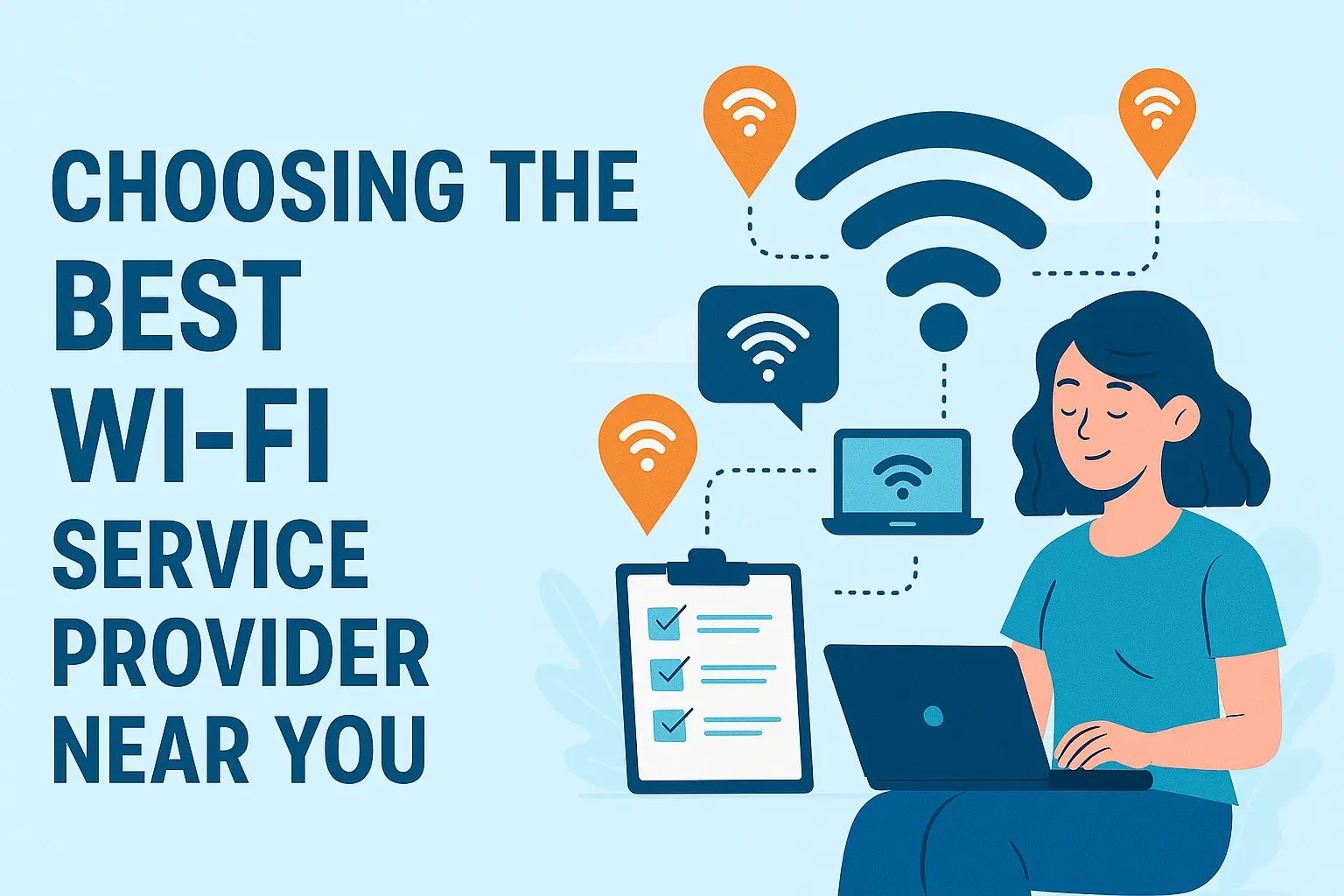How to Choose the Best Internet Provider in your area?

Finding the best internet provider in your area can feel like navigating a maze. This guide cuts through the complexity, offering a clear, step-by-step approach to compare plans, understand speeds, and secure the ideal internet service that fits your needs and budget for 2025.
Understanding Your Internet Options
The first step in choosing the best internet provider is understanding the different types of internet technology available. Each has its own strengths, weaknesses, and typical availability, which can vary significantly by location. For 2025, the landscape continues to be dominated by a few key players, with fiber optic technology seeing continued expansion.
Fiber Optic Internet
Fiber optic internet is generally considered the gold standard for speed and reliability. It uses thin strands of glass or plastic to transmit data as pulses of light, offering incredibly fast download and upload speeds. This makes it ideal for bandwidth-intensive activities like 4K streaming, online gaming, and large file transfers. Speeds can range from 100 Mbps to over 1,000 Mbps (1 Gbps), with some providers offering multi-gigabit plans.
- Pros: Highest speeds, symmetrical upload/download speeds, very reliable, low latency.
- Cons: Not yet available in all areas, can be more expensive.
Cable Internet
Cable internet is the most widely available high-speed internet option in many regions. It utilizes the same coaxial cable network that delivers cable television. While it offers significantly faster speeds than DSL, its performance can sometimes be affected by network congestion, especially during peak hours, as the bandwidth is shared among users in a neighborhood. Download speeds typically range from 50 Mbps to 1,000 Mbps, but upload speeds are usually much lower.
- Pros: Widely available, good download speeds, competitive pricing.
- Cons: Upload speeds are often much slower than download, potential for network congestion, reliability can vary.
DSL (Digital Subscriber Line) Internet
DSL internet uses existing telephone lines to transmit data. It's a more traditional form of broadband and is often the most affordable option, especially in rural areas where other high-speed options are unavailable. However, DSL speeds are generally the slowest among broadband technologies, and performance can degrade significantly with distance from the provider's central office. Speeds typically range from 5 Mbps to 100 Mbps.
- Pros: Widely available, affordable, uses existing phone lines.
- Cons: Slowest speeds, performance degrades with distance, upload speeds are very low.
Fixed Wireless Internet
Fixed wireless internet provides a broadband connection without physical cables. It works by transmitting a signal from a tower to a receiver installed at your home. This technology is often a good solution for rural or underserved areas where wired infrastructure is limited. Speeds can vary greatly depending on the provider and technology used, but can reach up to 100 Mbps or more in some cases.
- Pros: Good option for rural areas, no physical cable installation required.
- Cons: Performance can be affected by weather and line-of-sight obstructions, speeds can be inconsistent.
Satellite Internet
Satellite internet is the most accessible option for extremely remote locations where no other form of broadband is available. It works by sending and receiving signals from a satellite orbiting Earth. However, satellite internet is known for its high latency (delay), which can make real-time applications like video conferencing or online gaming frustrating. Speeds are also generally lower than other options, and data caps are common. For 2025, while advancements are being made, it remains a last resort for most users.
- Pros: Available almost anywhere.
- Cons: High latency, slower speeds, data caps, susceptible to weather interference, often the most expensive per Mbps.
Assessing Your Household's Internet Needs
Once you understand the types of internet available, the next crucial step is to honestly assess how your household uses the internet. This will help you determine the speed and data requirements you actually need, preventing you from overpaying for services you won't utilize or being frustrated by a slow connection.
Determine Your Internet Usage Habits
Consider the following questions for each member of your household:
- How many people use the internet simultaneously? More users mean more demand on the connection.
- What activities do you primarily use the internet for?
- Basic browsing and email: Low bandwidth requirements (e.g., 25-50 Mbps).
- Streaming standard-definition (SD) video: Moderate bandwidth (e.g., 50-100 Mbps per stream).
- Streaming high-definition (HD) video: Higher bandwidth (e.g., 100-200 Mbps per stream).
- Streaming 4K Ultra HD video: Significant bandwidth (e.g., 200-500 Mbps per stream).
- Online gaming: Requires good download speeds, but critically, low latency and stable upload speeds are also important.
- Video conferencing (e.g., Zoom, Google Meet): Moderate download and good upload speeds are crucial (e.g., 50-100 Mbps download, 20-50 Mbps upload).
- Working from home (especially with large file uploads/downloads or VPNs): High bandwidth and stable connections are essential.
- Smart home devices (e.g., smart thermostats, security cameras, voice assistants): These devices consume a small amount of bandwidth individually but can add up when multiple are active.
- Downloading/uploading large files (e.g., for work, school, or creative projects): High speeds are beneficial.
Estimate Required Speeds
Based on your usage, you can estimate the minimum and recommended speeds:
- For 1-2 users with light usage (browsing, email, occasional streaming): 25-50 Mbps download.
- For 2-4 users with moderate usage (HD streaming, some gaming, video calls): 100-200 Mbps download.
- For 4+ users with heavy usage (multiple 4K streams, extensive gaming, remote work, large file transfers): 300 Mbps to 1 Gbps or higher download.
Don't forget upload speeds! If you frequently video conference, upload large files, or stream yourself, aim for providers offering at least 10-20 Mbps upload, and ideally more if possible. Fiber optic providers often excel here, offering symmetrical speeds (e.g., 500 Mbps download and 500 Mbps upload).
Consider Data Caps
Many internet plans, especially DSL and satellite, come with data caps, which limit the amount of data you can download and upload each month. Exceeding these caps can result in extra charges or throttled speeds. For 2025, unlimited data plans are becoming more common, especially with fiber and cable providers, but it's essential to check the specifics.
- How much data do you typically use? Check your current provider's billing statement or use online data usage calculators.
- If you stream a lot of video or download large files, an unlimited data plan is highly recommended to avoid unexpected costs.
Researching Internet Providers in Your Area
With your needs defined, it's time to identify which internet providers actually serve your specific address. Availability is the biggest limiting factor in choosing an internet provider.
Use Online Availability Checkers
The most efficient way to start is by using online tools. Reputable websites and provider websites allow you to enter your zip code or full address to see which services are available. Some popular tools include:
- BroadbandNow.com
- HighSpeedInternet.com
- Fcc.gov/broadbandmap (Federal Communications Commission's official map)
- Individual provider websites (e.g., Verizon, AT&T, Spectrum, Xfinity, CenturyLink)
Be sure to check multiple sources, as sometimes one tool might miss a provider or a specific plan.
Identify Local and National Providers
You'll likely find a mix of national providers (e.g., Xfinity, Spectrum, AT&T, Verizon) and potentially smaller, regional, or local companies. Don't overlook local providers, as they sometimes offer competitive pricing or unique plans.
Gather Information on Available Technologies
As you identify providers, note down which technologies they offer at your address (Fiber, Cable, DSL, Fixed Wireless). This will help you filter options based on your needs assessment.
Look for Reviews and Local Feedback
Once you have a list of potential providers, look for reviews specifically mentioning your area or neighborhood if possible. Online reviews, local community forums, and even asking neighbors can provide valuable insights into:
- Actual speeds experienced (often different from advertised speeds).
- Reliability and uptime (how often does the internet go down?).
- Customer service quality (how easy is it to get help when you need it?).
- Installation process (was it smooth or problematic?).
While individual reviews can be subjective, a pattern of consistent praise or complaints can be a strong indicator.
Understanding Internet Speeds in 2025
Advertised internet speeds are often "up to" a certain number. For 2025, understanding what these numbers mean and what you can realistically expect is key. Speeds are measured in megabits per second (Mbps) for downloads and uploads.
- Download Speed: The speed at which your device receives data from the internet. Crucial for streaming, browsing, and downloading files.
- Upload Speed: The speed at which your device sends data to the internet. Important for video conferencing, uploading files, and online gaming.
What to Expect in 2025:
- Fiber Optic: Expect plans ranging from 300 Mbps to 2 Gbps or even 5 Gbps download and upload. These are the most consistent and reliable speeds.
- Cable: Download speeds can range from 100 Mbps to 1 Gbps. Upload speeds are typically much lower, often 10-50 Mbps. Some newer DOCSIS 4.0 implementations are improving upload speeds, but this is not yet widespread.
- DSL: Speeds are improving but generally remain in the 10-100 Mbps download range, with very low upload speeds (e.g., 1-10 Mbps).
- Fixed Wireless: Highly variable, but some providers are offering speeds up to 100-300 Mbps download.
Latency (Ping): This measures the time it takes for data to travel from your device to a server and back. Lower latency is better, especially for gaming and real-time communication. Fiber typically offers the lowest latency (under 20ms), while satellite has the highest (over 600ms).
Comparing Plans, Pricing, and Contracts
With a list of available providers and your needs in mind, it's time to dive into the specifics of their plans. This is where hidden costs and confusing terms can trip you up.
Analyze Advertised Speeds vs. Real-World Speeds
As mentioned, "up to" speeds are marketing terms. Look for reviews or ask current customers about their actual experience. A plan advertised at 500 Mbps might consistently deliver 400 Mbps, which could still be perfectly adequate, but it's good to have realistic expectations.
Understand Pricing Structures
Internet pricing can be complex. Be aware of:
- Introductory Pricing: Many providers offer a lower promotional rate for the first 12-24 months. After this period, the price will increase significantly. Always find out the standard rate after the promotional period ends.
- Bundling: Providers often offer discounts if you bundle internet with TV or phone services. Evaluate if the bundled price is truly a better deal than purchasing services separately, and if you actually need the bundled services.
- Contract Lengths: Some plans require a 12-month, 24-month, or even longer contract. Understand the terms and any early termination fees (ETFs) if you need to break the contract. Month-to-month plans offer more flexibility but might be slightly more expensive.
Compare Data Caps and Overage Fees
Reiterate your data needs. If a plan has a data cap, understand the cost of exceeding it. For example, a $70/month plan with a 1TB cap might seem reasonable, but if you frequently go over and incur $50-$100 in overage fees, it's no longer a good deal.
Create a Comparison Table
A table is an excellent way to visualize and compare different offers side-by-side. Here's an example of what to include:
| Feature | Provider A (Fiber) | Provider B (Cable) | Provider C (DSL) |
|---|---|---|---|
| Advertised Download Speed | 1000 Mbps | 500 Mbps | 100 Mbps |
| Advertised Upload Speed | 1000 Mbps | 30 Mbps | 10 Mbps |
| Monthly Price (Introductory) | $70 | $60 | $50 |
| Monthly Price (After 12 Months) | $90 | $80 | $60 |
| Contract Length | 12 Months | 24 Months | Month-to-Month |
| Data Cap | Unlimited | 1.5 TB | Unlimited |
| Installation Fee | $99 (waived with promo) | $50 | $20 |
| Equipment Rental Fee | $15/month | $10/month | $0 (use own modem) |
| Technology | Fiber Optic | Cable | DSL |
| Estimated Real-World Speed | ~900 Mbps | ~400 Mbps | ~70 Mbps |
Note: All prices and speeds are hypothetical examples for 2025. Actual figures will vary by location and provider.
Read the Fine Print
Before signing anything, carefully read the terms of service and contract. Pay attention to:
- Early Termination Fees (ETFs): How much will it cost if you break the contract?
- Price Increases: When and by how much will the price go up?
- Equipment Policies: Can you use your own modem/router to save on rental fees?
- Service Guarantees: Are there any uptime guarantees?
Evaluating Performance and Reliability
Speed and price are important, but a slow or frequently interrupted connection can be incredibly frustrating. Reliability and performance are often harder to quantify but are critical for a good internet experience.
Check Provider Reliability Ratings
While not always publicly available for specific local areas, national reliability reports and customer reviews can give you a general idea of a provider's track record. Look for information on:
- Uptime: How often does the service experience outages?
- Network Congestion: Is the service consistently slow during peak hours (evenings and weekends)?
Understand Network Congestion
Cable internet, in particular, can suffer from congestion because bandwidth is shared. If many people in your neighborhood are online at the same time, your speeds might drop. Fiber optic networks are far less susceptible to this issue due to their dedicated bandwidth.
Consider Latency (Ping) for Specific Activities
If you're a gamer, a remote worker who relies on VoIP, or a frequent video conferencer, latency is as important as speed. High latency means a noticeable delay between your action and the response. Fiber optic internet generally offers the lowest latency, making it ideal for these applications.
Research Customer Service and Technical Support
When things go wrong, you'll want a provider that offers responsive and helpful customer support. Look for reviews that mention:
- Wait times for support calls.
- The helpfulness and knowledge of support staff.
- The ease of scheduling technician visits.
- How quickly issues are resolved.
Some providers offer 24/7 support, which can be invaluable.
Look for Service Guarantees
Some providers offer service guarantees, such as a guaranteed uptime percentage or a credit on your bill if service is interrupted for an extended period. While rare, these can offer peace of mind.
Understanding Fees, Equipment, and Hidden Costs
Beyond the monthly service price, several other costs can significantly impact the total amount you pay for internet service.
Installation Fees
Most providers charge an installation fee. This can range from $0 (often with promotional offers) to over $100. Some may offer self-installation kits for free or a small fee, which can be a good way to save money if you're comfortable setting up the equipment yourself.
Equipment Rental Fees
Providers typically rent out modems and routers. These rental fees can add $10-$20 or more to your monthly bill. For 2025, many providers are allowing customers to use their own compatible equipment, which can lead to substantial savings over the life of your service. Check the provider's compatibility list carefully if you plan to use your own modem/router.
- Modem: Translates the signal from the provider's network to a signal your home network can use.
- Router: Creates your Wi-Fi network, allowing multiple devices to connect wirelessly. Often, modems and routers are combined into a single "gateway" device.
Activation Fees
Some providers charge a one-time activation fee to set up your service. This is separate from the installation fee and covers the administrative costs of getting your service online.
Taxes and Surcharges
Be aware that your monthly bill will also include various federal, state, and local taxes, as well as regulatory fees and surcharges. These can add an additional 10-20% to the advertised price.
Overages and Data Charges
As discussed, if your plan has a data cap, exceeding it will incur additional charges. Understand the per-gigabyte cost of overages.
Contract Renewal Increases
Remember that introductory pricing is temporary. Factor in the higher standard rate that will apply after your promotional period ends. Always ask for the "regular price" or "price after X months."
Promotional Offers and Discounts
Take advantage of available promotions. These can include:
- Waived installation fees.
- Discounted monthly rates for a set period.
- Free equipment rental for a limited time.
- Bundling discounts.
- Discounts for military, students, or low-income households.
Always ask about current deals and promotions when you call to sign up.
Making the Final Decision and Installation
You've done your research, assessed your needs, compared plans, and understood all the potential costs. Now it's time to make the choice and get connected.
Review Your Top Choices
Go back to your comparison table and your notes on reliability and customer service. Consider which provider offers the best balance of speed, price, reliability, and customer support for your specific situation. For 2025, if fiber is available and within your budget, it's often the superior choice for long-term satisfaction.
Contact the Provider to Sign Up
Once you've made your decision, contact the provider. You can usually do this online, by phone, or sometimes in person at a retail store.
- Have your account information ready (if switching from another provider, you might need your account number for porting your number if you're keeping your landline).
- Confirm all pricing and terms before you agree to anything.
- Ask about the installation process and schedule a date.
Prepare for Installation
On installation day, ensure someone over 18 is home. The technician will need access to where the internet line enters your home. They will typically:
- Install any necessary outdoor wiring or equipment.
- Run cables inside your home to the desired location for your modem/router.
- Connect and test the equipment.
- Set up your Wi-Fi network (or guide you on how to do it if you're using your own equipment).
Be prepared to discuss the best placement for your modem/router for optimal Wi-Fi coverage throughout your home.
Test Your Connection
After the installation is complete, run speed tests (using sites like Speedtest.net or Fast.com) on multiple devices and at different times of the day to ensure you're getting the speeds you expect. Test your Wi-Fi signal strength in various rooms.
Keep Records
Save all your contract documents, receipts, and any correspondence with the provider. This will be invaluable if any disputes arise later.
Monitor Your Service
For the first few weeks, pay close attention to your internet performance. If you experience consistent issues with speed, reliability, or connectivity, contact customer support immediately. Documenting these issues can be helpful if you need to escalate a complaint or decide to switch providers.
Consider Your Own Equipment
If you opted to rent equipment, research compatible modems and routers that you can purchase yourself. Over time, this can save you hundreds of dollars. Ensure the equipment you buy is compatible with your provider's network technology (e.g., DOCSIS 3.1 for cable, specific Wi-Fi standards for routers).
Choosing the best internet provider in 2025 involves a methodical approach. By understanding your needs, researching available technologies and providers, meticulously comparing plans and costs, and evaluating reliability, you can make an informed decision. Don't be swayed solely by introductory prices; always look at the long-term costs and the true value offered. With this comprehensive guide, you're well-equipped to secure an internet service that meets your demands and keeps you connected reliably and affordably.





